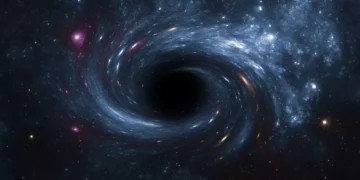At the heart of our Milky Way lies a region of intense gravitational forces, extreme cosmic phenomena, and a mysterious, unseen population of black holes. This area, surrounding the supermassive black hole Sagittarius A* (Sgr A*), has long fascinated astronomers. While we have identified young stars, dust clouds, and gas swirling in this chaotic center, the precise number of stellar-mass black holes residing there has remained elusive.
The Galactic Center: A Cosmic Hotspot
The Milky Way’s core is one of the most extreme environments in our galaxy. The presence of Sgr A*, a supermassive black hole with a mass of about 4 million times that of the Sun, dominates the region’s gravitational landscape. Observations using infrared and radio telescopes have revealed young, massive stars clustered in the vicinity, as well as dense clouds of interstellar gas.
However, despite advanced astronomical instruments, one component has remained largely invisible: stellar-mass black holes. These black holes, formed from the collapse of massive stars, emit little to no radiation unless they are actively consuming material. This makes detecting them extremely difficult, leading to uncertainty about their numbers in the galactic center.
The Star Grinder Model: A Black Hole Factory
The newly proposed “Star Grinder” model presents a compelling explanation for the hidden black holes in the region. According to this theory, the galactic center’s high density of gas and dust creates ideal conditions for the birth of massive O-type and B-type stars. These stars have relatively short lifespans, often only a few million years, before exploding as supernovae and leaving behind black holes. Over cosmic timescales, this continuous cycle results in the accumulation of an enormous number of stellar-mass black holes.
But the model goes further—suggesting that interactions between stars and black holes are not just possible, but frequent. In this densely packed environment, black holes would tear apart or consume passing stars, leading to a process of continuous recycling that enhances both black hole formation and destruction. This phenomenon, dubbed “black hole grinding,” could explain the relatively low number of observed O-type stars near Sgr A*—many may have been shredded before reaching their full lifetimes.
Testing the Theory: Signs of the Star Grinder in Action
One of the key predictions of the Star Grinder model is that the region should be filled with hypervelocity stars—stars that have been flung out of the galactic center at extreme speeds due to close encounters with black holes. Observations of the Milky Way’s halo have revealed several such high-speed stars, some moving fast enough to escape the galaxy entirely.
Another supporting piece of evidence comes from the observed distribution of massive stars in the galactic core. The lack of large O-type stars compared to smaller B-type stars may indicate that the larger, more massive stars are more frequently destroyed by black hole interactions. If black holes dominate the center, their gravitational influence should be responsible for this trend.
Astronomers aim to test the Star Grinder hypothesis through advanced computer simulations and direct observations using telescopes such as the Very Large Telescope (VLT), the James Webb Space Telescope (JWST), and future missions dedicated to black hole detection.
Implications for Galactic Evolution and Black Hole Studies
If the Star Grinder model holds true, it would have profound implications for our understanding of black holes and galaxy formation.
- A Galactic Core Swarming with Black Holes – The possibility of millions of black holes concentrated in a relatively small region could help explain some of the extreme gravitational effects observed near Sgr A*. This would also mean that star formation in this region is significantly influenced by these compact objects.
- Hypervelocity Stars as Messengers – Studying high-speed stars ejected from the galactic center could provide indirect evidence of frequent black hole interactions. Their trajectories and velocities can help astronomers reconstruct the chaotic gravitational environment near Sgr A*.
- A New Perspective on Dark Matter – Some theories suggest that dark matter may cluster around black holes. If the Star Grinder model is accurate, it could offer new ways to study dark matter by observing how it behaves in the presence of such a dense black hole environment.
- Understanding Black Hole Growth – Stellar-mass black holes near the center of the Milky Way might occasionally merge, forming larger black holes and contributing to the growth of Sgr A* over time. This could provide insight into how supermassive black holes evolve.
Challenges and Future Research
Despite its exciting possibilities, the Star Grinder model faces challenges in verification. Since stellar-mass black holes do not emit visible light, astronomers must rely on indirect detection methods, such as observing how they influence nearby stars or detecting gravitational waves from black hole mergers.
Future projects, such as the Laser Interferometer Space Antenna (LISA), which is designed to detect low-frequency gravitational waves, may offer a clearer picture of black hole interactions in the galactic center. Additionally, next-generation telescopes, such as the Extremely Large Telescope (ELT), could provide high-resolution imaging that may help identify hidden black holes through their effects on surrounding stars.
Conclusion
The concept of the Star Grinder challenges previous assumptions about the galactic core, suggesting that the region around Sgr A* is far more dynamic than previously thought. If confirmed, this model could change how we view the heart of our galaxy, revealing a hidden, turbulent environment where black holes dominate the landscape, consuming and recycling stars in a relentless cosmic process.
Reference:
Haas, J., et al. “The star grinder in the Galactic centre-Uncovering the highly compact central stellar-mass black hole cluster.” Astronomy & Astrophysics 695 (2025): L19.



















